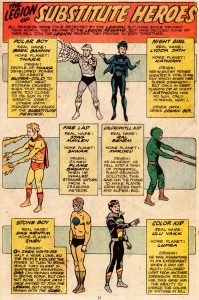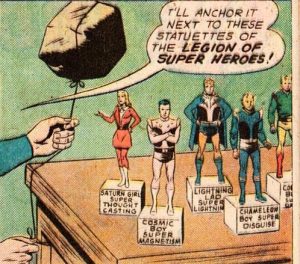 Yesterday I wrote a long piece about the “new” story in this issue. Now I’ll turn to the reprints.
Yesterday I wrote a long piece about the “new” story in this issue. Now I’ll turn to the reprints.
To begin with, there’s an info page titled, “The Legion of Substitute Heroes.” This introduces six people who don’t appear anywhere else in the issue, but are part of a splinter group. It’s explained that they’re rejected Legion applicants who have since proved themselves. I always loved the collection of powers. Some are so lame that one wonders why these kids didn’t just become accountants—I’m looking at you Stone Boy and Color Kid!—while one wonders why an applicant like Polar Boy would ever have been rejected in the first place. Of course, he did eventually become a Legionnaire. But Stone Boy, the feature tells us, was offered a slot first.
Really? Stone Boy. Huh.
Even at age nine, I was a little skeptical about someone gaining super powers by falling into a vat of plant food. (If I’d believed it, I probably would have tried it!) On the other hand, it took me a few weeks to realize what “Dates Cosmic Boy” meant in reference to Night Girl. At first I thought they meant they were born on the same day. I was really unsophisticated!
“Lana Lang’s Superboy Identity Detection Kit”
The opening narrative tells us that Lana doesn’t want to be the most beautiful woman in the world, or have a huge collection of jewelry—no, she just wants to prove that Superboy is secretly Clark Kent, her next-door neighbor. Funny how none of Clark Kent’s male friends—of any age—seemed the least damn bit interested in proving he was Superman; but Lana during his teen years and Lois during his adult years, at least until around 1970, were both determined to prove that Clark and Superman were the same person. It was an obsession for them both.
Talk about having no sense of your own identity!
The plot for this one is pretty straightforward—Lana follow Superboy around for a couple of days, trying to catch him switching identities. She never does. She watches him foil a prison break, put out a fire, stop a lightning storm—whoa there! Stop a lightning storm? Even in the 1960s, was that something heroes were expected to do? I mean, lightning storms just happen. They’re part of nature. If you, I dunno, move the storm system to a different location, you’re probably screwing with a delicate, natural balance, and I bet you have no idea what impact your one action will have in a hundred other places. Especially if you’re a high school sophomore with a small-town public school knowledge of science.
I’m being harsh. Clark, of course, had access to his biological father’s Kryptonian knowledge of science, and was also a super-genius. And the idea of weather control was fashionable in science fiction circles back in the day. There was a profound sense of optimism about the human ability to influence our environment for the better. I’m not sure the death—or at least suspended animation—of that optimism is a good thing, for all that I think “moving a storm” is a bad idea.
 In the end, of course, Lana does not prove that Clark is Superboy. She does prove that the 1960s were a different time, though, when she gets thrown over her father’s knee for a hairbrush spanking as punishment for being stupid. (Yeah, Prof Lang called his daughter “stupid” and was about to beat her with a brush—another candidate for father of the year fallen.) Proving himself a buffoon, Prof Lang calls off the spanking before the first stroke, realizing his daughter is too old.
In the end, of course, Lana does not prove that Clark is Superboy. She does prove that the 1960s were a different time, though, when she gets thrown over her father’s knee for a hairbrush spanking as punishment for being stupid. (Yeah, Prof Lang called his daughter “stupid” and was about to beat her with a brush—another candidate for father of the year fallen.) Proving himself a buffoon, Prof Lang calls off the spanking before the first stroke, realizing his daughter is too old.
Lana’s final attempt is foiled, though, not by Superboy, but by Chameleon Boy of the Legion of Super-Heroes, who was visiting Clark from the 30th Century to interview him for the “Super-Hero club newspaper.” If that sounds a little off to long-time Legion fans, it’s because this is one of many stories featuring Legionnaires which appeared before they had their own series. This story, which originally ran in Superboy #93 from December, 1961, came a full year before the Legion’s own premiere as front-runners in Adventure Comics #300.
 This is one of many stories from those early years—like Sun Emperor’s first appearance in an issue of Jimmy Olsen’s title—which does not appear in DC’s Legion Archives, and is therefore an obscured piece of history today. In a lot of these stories, the futuristic tone of the main series is missing. Indeed, the only reason casual readers would have known who Chameleon Boy was is that Superboy makes a reference, early in the story, to his collection of statues of his fellow Legionnaires. In that same scene, by the way, we see a still-white-haired Jonathan and Martha Kent.
This is one of many stories from those early years—like Sun Emperor’s first appearance in an issue of Jimmy Olsen’s title—which does not appear in DC’s Legion Archives, and is therefore an obscured piece of history today. In a lot of these stories, the futuristic tone of the main series is missing. Indeed, the only reason casual readers would have known who Chameleon Boy was is that Superboy makes a reference, early in the story, to his collection of statues of his fellow Legionnaires. In that same scene, by the way, we see a still-white-haired Jonathan and Martha Kent.
Not sure who wrote this one, and, while it was fun, I really always was bothered by the exceptionally bratty characterizations of Lana, and later Lois. Contrasted with contemporary stories about the Legion, and the way females were written there, it comes up short. I do think the Legion broke new ground with its female characters, being one-third or more female from the beginning, which was well beyond the one-to-seven ratio the JLA and JSA had, better even than the representation in the Fantastic Four, the X-Men or the Avengers.
Tomorrow I’ll talk about Saturn Girl’s role in the classic Legion a bit more, as demonstrated in the final tale in this issue, “The Evil Hand of the Luck Lords.”

